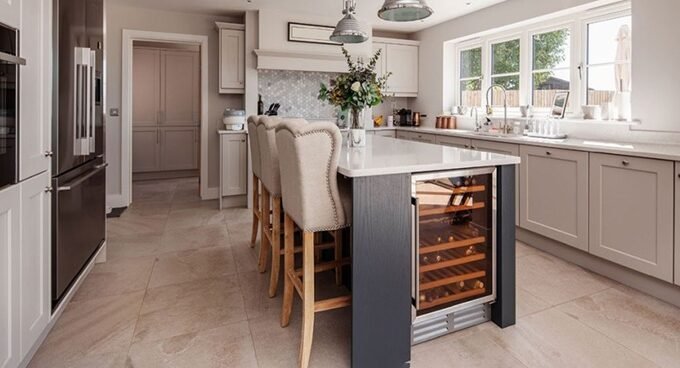
What Makes a Good Dining Area?
The dining area in your home is a special place where the whole family, friends, and guests get together to enjoy some delicious meals and good times together. This is where you can spend quality time with your loved ones over a cup of coffee or a meal. Thus, if you are thinking of designing a dining room or planning to renovate it, you need to ensure that you get perfect results in terms of space and functionality.
A good dining area creates a comfortable space for complete relaxation and effortless connections over food. This is why designers and decorators focus on the precise dimensions of the room, what kind of furniture, such as wood or glass dining tables, to use, and make informed decisions regarding the lighting and decorations. The aim is to optimize the functionality and accentuate your space to get that perfect dining space, whether in your home or in a commercial area.
Let us have a look at some of the essential elements that can make a good dining area.
Table of Contents
ToggleConsider the size and space
He first and foremost condition is to ensure that there is adequate space for the furniture and the guests to move around within the dining space. One should not feel uncomfortable or cramped when dining. The size of furniture and number of furniture items you buy should be as per the size and needs of the room. While spacious dining areas allow more freedom, one has to be careful when designing a smaller space.
Relaxed and comfortable seating
When shopping for dining room furniture, look for comfortable chairs for a relaxed mealtime experience. The size, design, and number of furniture items will again depend on the space, the needs, and the aesthetics of the room. As comfort holds paramount importance in any dining area, look for ergonomically designed chairs with adequate support and a table of appropriate height for a comfortable dining experience.
Good ventilation and appropriate lighting
The dining area should have ample light and air to create a fresh and cozy ambiance. People often need to pay more attention to the elements of light and ventilation, and as a result, one often finds some dining spaces to be dull, dark, and stuffy. Place adjustable lighting to ensure proper lighting at all times and enough airflow to keep the space fresh and comfortable. There should be adequate lighting and ventilation in the dining area, whether it is a casual or formal dining experience.
Add an aesthetic appeal with a personalized touch
The visual aesthetics play a strong role when it comes to planning and designing the dining area. Whether it is the color scheme, the furniture, the décor, or the lighting, the results should be visually pleasing and impact the mood. What can make the area even more special and unique is your personal touch, and you can add small personal touches such as placing a custom artwork or creating a centerpiece to reflect the personality of the homeowner. It is essential to get an aesthetically pleasing result that motivates people to spend more time in the dining space.
Create a visually pleasing environment. Aesthetics can influence mood and appetite, making it important for the dining area to be appealing.
Personalized Touch:
Adding a personalized touch to the dining area can make it more memorable and unique. This could be achieved through custom artwork, themed decor, or small personal touches that reflect the personality of the restaurant or homeowner.
Noise Control:
Noise levels can greatly affect the dining experience. A good dining area should have noise control measures in place to minimize excess noise from kitchen activity or conversations at nearby tables. Acoustic panels, soft furnishings, and appropriate layout can help with noise reduction.
Cleanliness and Hygiene:
Cleanliness is a fundamental requirement for any dining area, whether it’s in a home or a restaurant. Tables, chairs, utensils, and surfaces should be spotless. An unclean dining area can deter diners and lead to a negative dining experience.
Functional Layout:
The layout of the dining area should be functional and allow for efficient service. This includes the placement of tables, the arrangement of seating, and the location of service areas. A well-planned layout contributes to a smooth dining experience for both diners and staff.
Access to Natural Elements:
If possible, a good dining area should have access to natural elements like outdoor views, fresh air, or natural light. These elements can enhance the dining experience, create a sense of connection with nature, and provide a refreshing atmosphere.
Accessibility:
Accessibility is essential to ensure that all individuals, including those with disabilities, can enjoy the dining area. This includes ramps, wide entrances, and accessible restroom facilities.
Greenery and Plants:
Incorporating greenery and indoor plants can add a touch of nature to the dining area, making it feel more inviting and fresh.
In conclusion, a good dining area is more than just a place to eat; it’s an environment carefully designed to enhance the overall dining experience. Comfort, aesthetics, functionality, and cleanliness are key elements that contribute to the success of a dining area, whether it’s in a home, a restaurant, or another type of dining establishment. When these elements come together harmoniously, diners can truly savor their meals and enjoy memorable dining moments.
Anthony M. Salvatori is President of Steadfast Painting Solutions. He has 20 years of painting experience and has been operating his own company for nine years. Salvatori is proud to be leading such an incredible team of individuals with the common goal of providing excellent service and quality.






